Radiator connection kit: recommendations for selection,
Anyone who decides to independently engage in the installation of heating communications should carefully understand what is needed to connect a heating radiator. The list and number of necessary elements depends on the type of wiring and modification of batteries, in this review we will consider the main options that are used most often and have proven themselves on the positive side.

Basic recommendations for the selection of components
Regardless of which option will be used in your case, there are several important criteria that any type of product must meet:
| Thread matching | You will not be able to use the radiator connection kit 1 2-1 for fittings with a diameter of 3 4. That is, you must understand which pipes will be laid and what type of connections to the radiator will be used, since these materials are much more expensive and easier to adjust to them. features than to purchase components for existing kits |
| Quality | Even if you carry out all the work at the highest level and in accordance with the technology, this does not guarantee a good result. Low-quality products will negate all your efforts, and you will have to carry out repair work much earlier than it should have been, so choose products of well-known brands that have a good reputation among buyers and specialists. |
| Appearance | Products may differ in the outer coating, so decide in advance which option is best for you. The main options are: white powder coating and chrome-plated surface. Of course, if you wish, you can repaint the painted nodes |
Note! It is best to purchase kits for connection with radiators, then you are guaranteed to get what you need.
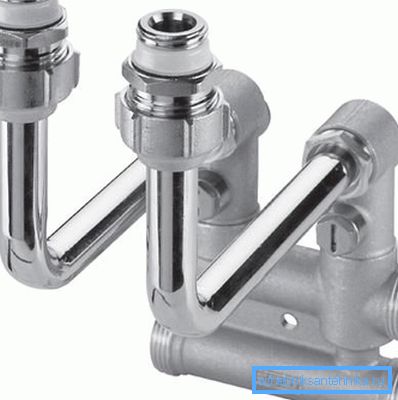
The main options and their features
Consider what types of products are used depending on the type of radiators and what should be included in the set. The package bundle may differ depending on some factors, we will also discuss this in this chapter.
Connection Kits
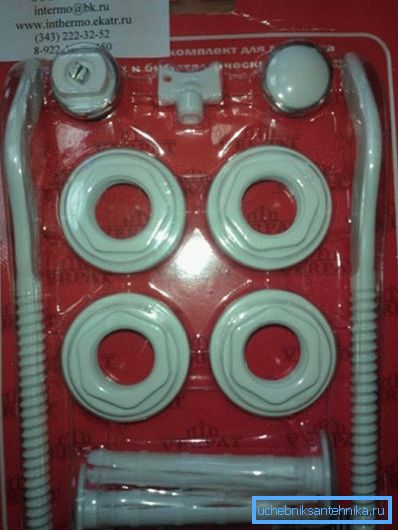
So called special kits, which are used to attach pipes to aluminum, bimetallic, cast iron and other radiators of similar design.
Typically, the package includes the following components:
- Lugs - they are used to connect pipes to the radiator, they represent a fastening element, in which the external thread is always 1 inch, and the internal thread can be? or ? inches depending on pipe diameter. When purchasing components, you should know the type and material of the manufacture of the pipes you use, so that the seller will choose the best option for you
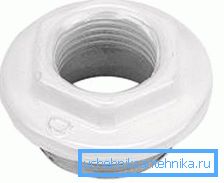
- Mayevsky's crane - a very important element in any system, since it removes air from the radiator, which degrades battery performance. The node is a special valve that opens with a key that should be included in the package. A valve is installed at the top of the system, since air accumulates there;
- Cap It is used to close one of the holes, because of the four terminals on the battery, only three are always used: two for water input and output and one for Mayevsky's tap. This element is a small lid that is screwed into the inside of the desired futorki;
- Mounting brackets are necessary in order to securely fix the radiator on the wall, so this element should also be given great attention. The design must be strong, so the use of too shaky holders is unacceptable.
Note! If the brackets included in the universal kits do not suit you, then the best option would be to purchase the kit without them, and the holders themselves to buy separately. Most often this is required when using cast-iron radiators (they are very heavy) and when fastening elements to wood (there is used a fastener in the form of a corner).
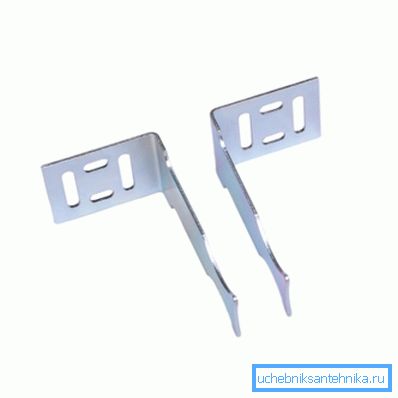
To understand how to use a kit for connecting a radiator, there is always a manual or on the back of the package there is always an instruction that tells all the main nuances, we will give only the most important recommendations:
- You should not apply excessive force when tightening the connections, especially when working with aluminum radiators, you can break the thread - and the design will be damaged;
- Always use sealing elements for the thread, this will prevent leakage during operation. You can use both modern options and the classic solution - tow and paint, the price of this option is low, but reliability meets the highest standards;

Special nodes
The radiator connection node is intended for radiators in which the inlet and outlet connections are located side by side (most often the center distance is 50 mm). This design is used in steel panel radiators, convectors and other types of equipment.
Regarding this option, you can tell the following:
- This design is a node in which there is a connection for the supply and return lines, the shape and size of this element may vary depending on the system, but still we recommend finding out what options are there so that you don’t have to redo the communication;
- Differences nodes for single-pipe and two-pipe systems are in the bypass, in the first case it is always open, and the second is always closed. Although commercially available and versatile options that allow you to independently open or close the valve on the bypass, thus it can be adapted to any system;

- The system of connecting radiators with a lower connection differs in its configuration from the options described above. First, you need to determine how the pipe leads are located (they can be removed from the wall, or from the floor), and second, measure the distance from the radiator to the pipeline to find the right option.

If you do the work yourself and get everything you need, then do not forget that the mounting junction does not include brackets, you need to make sure that they are included in the radiator delivery set, but if they are not there, then purchase the fasteners separately.
Recommendations for work are similar to the above - do not be zealous when tightening the nuts and seal all threaded connections.
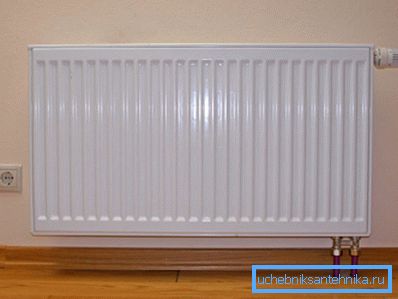
Conclusion
If you know all the features of the future system, then it will be difficult to choose the best kit for connecting radiators to the pipeline. Naturally, it is best to order everything at once, so that the supplier can pick up all the components at the same time as the radiators, so you will save yourself from unnecessary worries. The video in this article will help to understand some of the important nuances of the topic.